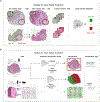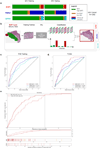Intratumoral Resolution of Driver Gene Mutation Heterogeneity in Renal Cancer Using Deep Learning
- PMID: 35654752
- PMCID: PMC9373732
- DOI: 10.1158/0008-5472.CAN-21-2318
Intratumoral Resolution of Driver Gene Mutation Heterogeneity in Renal Cancer Using Deep Learning
Abstract
Intratumoral heterogeneity arising from tumor evolution poses significant challenges biologically and clinically. Dissecting this complexity may benefit from deep learning (DL) algorithms, which can infer molecular features from ubiquitous hematoxylin and eosin (H&E)-stained tissue sections. Although DL algorithms have been developed to predict some driver mutations from H&E images, the ability of these DL algorithms to resolve intratumoral mutation heterogeneity at subclonal spatial resolution is unexplored. Here, we apply DL to a paradigm of intratumoral heterogeneity, clear cell renal cell carcinoma (ccRCC), the most common type of kidney cancer. Matched IHC and H&E images were leveraged to develop DL models for predicting intratumoral genetic heterogeneity of the three most frequently mutated ccRCC genes, BAP1, PBRM1, and SETD2. DL models were generated on a large cohort (N = 1,282) and tested on several independent cohorts, including a TCGA cohort (N = 363 patients) and two tissue microarray (TMA) cohorts (N = 118 and 365 patients). These models were also expanded to a patient-derived xenograft (PDX) TMA, affording analysis of homotopic and heterotopic interactions of tumor and stroma. The status of all three genes could be inferred by DL, with BAP1 showing the highest sensitivity and performance within and across tissue samples (AUC = 0.87-0.89 on holdout). BAP1 results were validated on independent human (AUC = 0.77-0.84) and PDX (AUC = 0.80) cohorts. Finally, BAP1 predictions correlated with clinical outputs such as disease-specific survival. Overall, these data show that DL models can resolve intratumoral heterogeneity in cancer with potential diagnostic, prognostic, and biological implications.
Significance: This work demonstrates the potential for deep learning analysis of histopathologic images to serve as a fast, low-cost method to assess genetic intratumoral heterogeneity. See related commentary by Song et al., p. 2672.
©2022 American Association for Cancer Research.
Conflict of interest statement
Figures





Comment in
-
Investigating Morphologic Correlates of Driver Gene Mutation Heterogeneity via Deep Learning.Cancer Res. 2022 Aug 3;82(15):2672-2673. doi: 10.1158/0008-5472.CAN-22-2040. Cancer Res. 2022. PMID: 35919991
References
-
- Dagogo-Jack I, Shaw AT. Tumour heterogeneity and resistance to cancer therapies. Nat Rev Clin Oncol 2018;15:81–94 - PubMed
Publication types
MeSH terms
Substances
Grants and funding
LinkOut - more resources
Full Text Sources
Medical
Miscellaneous

